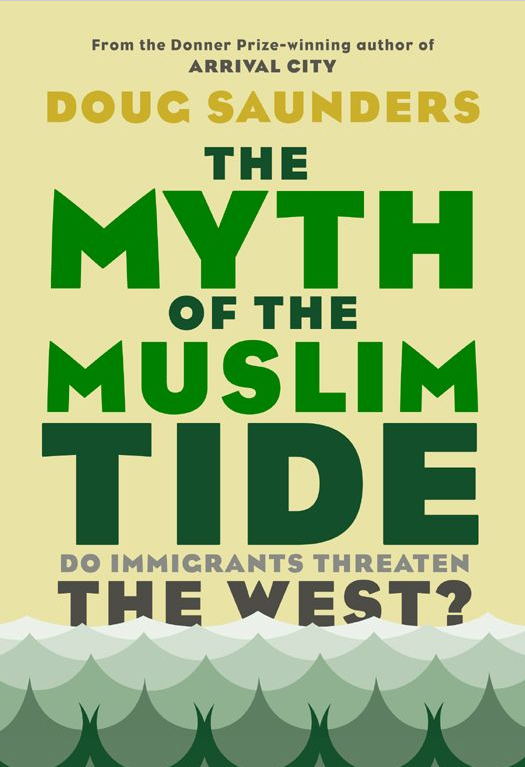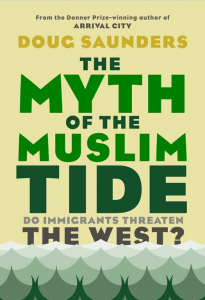The Myth of the Muslim Tide is a timely, sober and exhaustively researched book. British-Canadian Globe and Mail journalist Doug Saunders clearly and effectively debunks a number of irrational yet widely circulated demographic and historical claims by drawing on popular political literature, quantitative data and opinion polls. The short book is a useful tool with which to counteract the heightened post-9/11 notion of an imminent avalanche of Muslim immigrants bent on taking over Western countries from within, a goal parallel with that of the Euro-Islam network.
These ideas matter because they are not solely the fodder of extremists. Saunders frames the book around his experience of reading Anders Breivik’s manifesto, but we know these beliefs are foundational for political leaders like Geert Wilders in the Netherlands, parties that have anti-Muslim-immigration agendas in Scandinavia, the National Front in France and so on.
My own anthropologically-based work with Muslims outside of Paris,in the Greater Toronto Area and in St. John’s, Newfoundland has led me to findings similar to Saunders’: that public debate and, at times, governmental and legal policies are marked by misinformation about the population, birth rates and lack of extremism among the majority of Western Muslims.
While my work is qualitative, Saunders’ data are dryly and dispassionately accurate and say a great deal about disparities between influential conservatives’ claims and the realities of European and North American Muslims (who I find he sweeps together a bit too easily). Saunders’ claims that, “The truth about Muslim communities is not found in scripture but in action” (7) is on the mark and one with which many social scientists would agree.
To my mind the book’s strengths lie in the latter half of the book where he shows how Catholics in the US in the 18th and 19th Centuries and Jews in Europe in the early 20th Century were perceived with some of the same tone and racist scaremongering as Muslims today. There is, in sum, precedence for this discourse and history is a useful tool to show these trends.
Lastly, while Saunders’ overview of the privatization of religion is a bit too facile, his observation of how “Muslimness” is increasingly used as a trumping marker and identifier of peoples who have a number of other identifiers (as parents, immigrants, workers, siblings, of specific ethnic groups) is accurate . “The Muslim People” or ummah are catchalls that are also increasingly used by Muslims who find them politically unifying and theologically expedient. Saunders makes clear that the sheer variety of Islamic ways of life escape easy categorization.
There are two elements of the book I felt could have been further developed. Firstly, I wished Saunders had further developed the emotional quotient of these “tides.” He alludes to this feature in the opening of the book when he describes his visceral response to the changing so-called ethnic shops in his London neighborhood, his babysitter’s religious conversion and in a short section on “Self-Hating Westerners” that suggests that some Europeans see themselves at fault for this “tide” in becoming spiritually and morally bankrupt (20).
It seems to me that the emotional element in encountering difference is far more complex than charting fertility trends and speaks to why, for instance, autobiographies of Muslim women experiencing intimate partner violence are bestsellers in Western Europe and North America when we know that women of all ethnic and socioeconomic backgrounds experience abuse. As a side note, when Saunders says in his introduction that he aligns himself with popular “Enlightenment fundamentalist” Ayaan Hirsi Ali, I became worried. Social scientists like Saba Mahmood and Sherene Razack have effectively shown how Infidel (2007) does more damage in presenting an Orientalist homogenized patriarchal package than some of the authors Saunders critiques like Orianna Falacci or Mark Steyn. Fortunately this early appreciation does not lead Saunders to adopt Hirsi Ali’s neo-Orientalist positions.
Getting back to the emotional equation, I wished Saunders had more clearly articulated and considered the language of encounter. In my own work I have critiqued the French policy and legal arms of the Sarkozy government’s treatment of hijabs (2011), but I appreciate that a significant portion of the 2010 644-page government report that prefaced the so-called “burqa ban” treats the emotional experience of engaging with someone whose face is covered and who has different eating habits, beliefs and sexual politics.
Saunders recognizes the anxiety of the “politics of the neighbor” but his purely logical analytical response does not capture how one might feel if one’s child’s kindergarten teacher wears a niqab in the classroom. Granted, there are few niqabis in Canada – there are an estimated 25 in the province of Quebec where a bill has been recommended to ban them from public services – but while I might know that she is not intent on promoting Sharia in the criminal code, I might still wonder how I should address this teacher. This book does not deal with this pervasive affective issue, which is essential.
Secondly, I think it’s worth thinking about the intended audience for the book. Saunders reflexively shares his own anxieties and fears, questioning his own responses, imagining his readers to be in the same boat. This tone allows for an openness and lack of judgment. Readers, like Saunders, might have major concerns when their babysitter converts (or reverts) to Islam but don’t want to be bigoted or racist in their responses.
However, his appeasement-filled language on the one hand and extensive use of “us” (the readers) and “them” (the Muslim immigrants) on the other is confusing. It effectively maintains “them” as outsiders, which appears to counter his primary goal. We must also consider the possible effects of focusing on a lack of threat from Muslims in particular. Can reading this book actually shift a discursive stratagem away from the notion of Islamic threat or does this book participate in the construction of a global and decontextualized Muslim other by insisting that Muslims are largely benign?
In sum, as Saunders himself noted at a Big Thinkers’ Event at the University of Victoria in June 2013, “I wrote this book for that uncle”. The book is intended for a wide general audience. Academics may find it a useful reference for undergraduate students; policy makers and journalists will find the data in this well-researched book useful and compelling.







